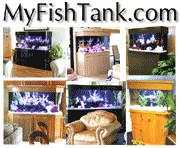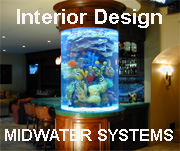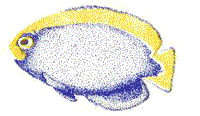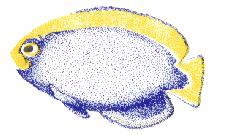|
System requirements for Clownfish
By Stanley Brown
The Breeders Registry
Anemonefishes generally do not require an elaborate system to maintain
good health. For most species a 20-gallon aquarium is adequate and
some professional breeders maintain broodstock pairs in 10-gallon aquariums
(pers.comm. Joe Lichtenbert 2000) . It is common to maintain a spawning
pair in a “community tank”, although due to conspecific aggression is it
not advisable to keep multiple pairs (even if different species) in the
same tank UNLESS IT IS A TANK OF GREAT VOLUME. Physical surface/substrate
area is more critical than tank volume. In the wild anenomefishes
territories are not large in comparison to other damselfishes and this
may be a contributing factor to their success in aquariums.
In aquariums the threat of predators is eliminated by the aquarist,
who, if careless, may be the greatest predator the captive inhabitants
may have to face! This removal of predators makes it unnecessary
to keep the anemonefishes with a host anemone. Anemones are much
more difficult to maintain than clownfish and have more rigid requirements
(lighting being a key requirement) and they also represent an increased
bio-load on the system. If you are insistent on keeping an anemone
with the anenomefishes, realize that this will place additional requirements
and demands on the system. It is well documented that anemonefishes
will spawn in captivity in the absence of an anemone (Fautine & Allen
1994, Moe , Wilkerson 1999 ).
Lighting requirements are not critical providing that a light and dark
photoperiod be provided. A period of 14 hours light and 10 dark is
a common practice. Spectrum and intensity may be a consideration
if the aquarium contains organisms from high light environments OR
for undesirable algae/cyanobacteria. Filtration should be adequate
to maintain ammonia/ammonium and nitrate levels at below detectable levels.
Nitrates appear to be tolerated by the adults but it has been suggested
that elevated levels may interfere with larval development, contribute
to low hatchability, and be a contributing factor to misbarring.
Water movement should be adequate to support the filtration system and
provide for good gas exchange.
A suitable spawning site can be the surface of a rock, the glass, a
clay flower pot, a short section of 3” or 4” PVC pipe (color seems unimportant
), a ceramic tile, and even the side of nearby powerhead! Initially
it may be advisable to provide several possible “sites” and once the pair
has selected a site remove the others. Unless disturbed, the pair
will continue to spawn on the same site.
i- Fautine, Daphne G. & Allen, Gerald, R., 1994,
Anemonefishes and their Host Sea Anemones, Tetra Press, Germany.
ii- Personal communication, 2000, Joe Lichtenbert, Reef
Propagation’s, USA.
iii- Ibid. i
iv- Moe, Martin Jr., A., 1989, The Marine Aquarium Reference:
Systems and Invertebrates, Green Turtle Publications, USA
v- Wilkerson, Joyce D., 1998, Clownfishes: A Guide to
their Captive Care, Breeding & Natural History; ,Microcosm Ltd.,
USA
vi- Brown, Stanley D., 1998, Low Tech Larval Trap,
The Journal of MaquaCulture, Vol 6:1-17 |
|











